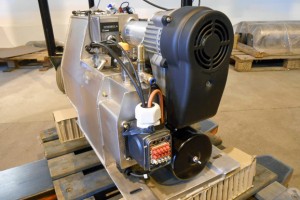Trams have to brake and accelerate at every stop on their journey. Braking in particular is a problem in wet weather. This is why many trams are fitted with sand spreaders to aid braking when the rails themselves do not provide sufficient friction. The spreaders are controlled by the driver and blow fine sand directly in front of the wheels on the rails. This increases the friction and helps the brakes grip securely to even wet or icy rails.
Compact and reliable
Despite being important tools for trams in everyday use, the sand spreaders need to be as compact as possible to minimise the amount of space taken up in the passenger area. For this reason, French company E.M.S. Concept turned to ebm-papst and its ECI 63 motor for the compressor, which creates the compressed air used to blow the sand onto the rails. The motor’s compact dimensions mean that the entire sand spreader can fit under a single block of seats.
Aside from this, the ECI 63 can be easily controlled via a 0-10 V input and requires no external control. “For safety systems like the sand spreader, reliability is also an important factor”, said Sébastien Lutz, Project Manager at E.M.S. Concept. And his colleague Richard Ostertag adds: “The motor can withstand even long periods of use. On top of this, we can significantly lower maintenance costs using a brushless motor.” Previously, sand spreaders had large brush motors installed that had a limited service life and also required much greater maintenance.
E.M.S. Concept’s sand spreaders are used on various tram routes in China. To optimise the ECI 63 for use in rail vehicles, ebm-papst’s engineers adjusted the basic firmware to easily handle the voltage fluctuations of up to 30 percent that are common in rail transport. This keeps the sand spreader ready for action whenever it gets a bit slippery on the rails.


Leave a comment